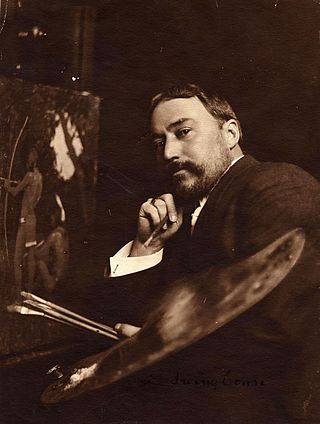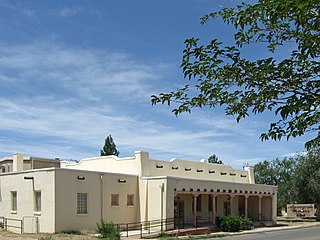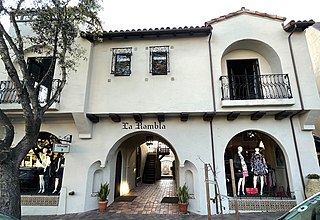
Taos is a town in Taos County in the north-central region of New Mexico in the Sangre de Cristo Mountains. Initially founded in 1615, it was intermittently occupied until its formal establishment in 1795 by Nuevo México Governor Fernando Chacón to act as fortified plaza and trading outpost for the neighboring Native American Taos Pueblo and Hispano communities, including Ranchos de Taos, Cañon, Taos Canyon, Ranchitos, El Prado, and Arroyo Seco. The town was incorporated in 1934. As of the 2010 census, its population was 5,716.

Eanger Irving Couse was an American artist and a founding member and first president of the Taos Society of Artists. Born and reared in Saginaw, Michigan, he went to New York City and Paris to study art. While spending summers in Taos, New Mexico, he began to make the paintings of Native Americans, New Mexico, and the American Southwest for which he is best known. He later settled full time in Taos.
The Maryland Institute College of Art (MICA) is a private art and design college in Baltimore, Maryland. Founded in 1826 as the Maryland Institute for the Promotion of the Mechanic Arts, it is regarded as one of the oldest art colleges in the United States.

Woodbridge is a historic neighborhood of primarily Victorian homes located in Detroit, Michigan. The district was listed on the National Register of Historic Places in 1980, with later boundary increases in 1997 and 2008. In addition to its historic value, Woodbridge is also notable for being an intact neighborhood of turn-of-the-century homes within walking or biking distance of Detroit's Downtown, Midtown, New Center, and Corktown neighborhoods.

The Chrysler Museum of Art is an art museum on the border between downtown and the Ghent district of Norfolk, Virginia. The museum was founded in 1933 as the Norfolk Museum of Arts and Sciences. In 1971, automotive heir, Walter P. Chrysler Jr., donated most of his extensive collection to the museum. This single gift significantly expanded the museum's collection, making it one of the major art museums in the Southeastern United States. From 1958 to 1971, the Chrysler Museum of Art was a smaller museum consisting solely of Chrysler's personal collection and housed in the historic Center Methodist Church in Provincetown, Massachusetts. Today's museum sits on a small body of water known as The Hague.

The Brush Park Historic District is a neighborhood located in Detroit, Michigan. It is bounded by Mack Avenue on the north, Woodward Avenue on the west, Beaubien Street on the east, and the Fisher Freeway on the south. The Woodward East Historic District, a smaller historic district completely encompassed by the larger Brush Park neighborhood, is located on Alfred, Edmund, and Watson Streets, from Brush Street to John R. Street, and is recognized by the National Register of Historic Places.

The Swiss Avenue Historic District is a residential neighborhood in East Dallas, Dallas, Texas (USA). It consists of installations of the Munger Place addition, one of East Dallas' early subdivisions. The Swiss Avenue Historic District is a historic district of the city of Dallas, Texas. The boundaries of the district comprise both sides of Swiss Avenue from Fitzhugh Street, to just north of La Vista, and includes portions of Bryan Parkway. The District includes the 6100-6200 blocks of La Vista Drive, the west side of the 5500 block of Bryan Parkway the 6100-6300 blocks of Bryan Parkway, the east side of the 5200-5300 block of Live Oak Street, and the 4900-6100 blocks of Swiss Avenue. The entire street of Swiss Avenue is not included within the bounds of the Swiss Avenue Historic District. Portions of the street run through Dallas' Peaks Suburban Addition neighborhood and Peak's Suburban Addition Historic District. 5215 Swiss was built in 1914 and was the home of J. P. Cranfield

The Morris–Butler House is a Second Empire-style house built about 1864 in the Old Northside Historic District of Indianapolis, Indiana. Restored as a museum home by Indiana Landmarks between 1964 and 1969, the American Civil War-era residence was the non-profit organization's first preservation project. Restoration work retained some of its original architectural features, and the home was furnished in Victorian and Post-Victorian styles. Its use was changed to a venue for Indiana Landmarks programs, special events, and private rentals following a refurbishment in 2013. Regular daily tours of the property have been discontinued.
Theodore Clement Steele was an American Impressionist painter known for his Indiana landscapes. Steele was an innovator and leader in American Midwest painting and is one of the most famous of Indiana's Hoosier Group painters. In addition to painting, Steele contributed writings, public lectures, and hours of community service on art juries that selected entries for national and international exhibitions, most notably the Universal Exposition (1900) in Paris, France, and the Louisiana Purchase Exposition (1904) in Saint Louis, Missouri. He was also involved in organizing pioneering art associations, such as the Society of Western Artists.

The South Side Community Art Center is a community art center in Chicago that opened in 1940 with support from the Works Progress Administration's Federal Art Project in Illinois. Opened in Bronzeville in an 1893 mansion, it became the first black art museum in the United States and has been an important center for the development Chicago's African American artists. Of more than 100 community art centers established by the WPA, this is the only one that remains open.

The Alwyn Court, also known as The Alwyn, is an apartment building at 180 West 58th Street, at the southeast corner with Seventh Avenue, in the Midtown Manhattan neighborhood of New York City. The Alwyn Court was built between 1907 and 1909 and was designed by Harde & Short in the French Renaissance style. It is one of several luxury developments constructed along Seventh Avenue during the late 19th and early 20th century.
C. M. Russell Museum Complex is an art museum located in the city of Great Falls, Montana, in the United States. The museum's primary function is to display the artwork of Great Falls "cowboy artist" Charles Marion Russell, for whom the museum is named. The museum also displays illustrated letters by Russell, work materials used by him, and other items which help visitors understand the life and working habits of Russell. In addition, the museum displays original 19th, 20th, and 21st century art depicting the American Old West and the flora, fauna, and landscapes of the American West. In 2009, the Wall Street Journal called the institution "one of America's premier Western art museums." Located on the museum property is Russell's log cabin studio, as well as his two-story wood-frame home. The house and log cabin studio were designated a National Historic Landmark in 1965, and added to the National Register of Historic Places in 1966. In 1976, the listing boundaries were amended to account for moving the house.

The Sugar Hill Historic District is a historic district in Detroit, Michigan. It contains 14 structures located along three streets: East Forest, Garfield, and East Canfield, between Woodward Avenue on the west and John R. on the east. The district was listed on the National Register of Historic Places in 2003.

Charles William Bolsius - was born in 's-Hertogenbosch, the Netherlands, the youngest in an upper-middle-class bourgeoisie family. His father ran the regional Gas Works and Bolsius formally studied art in The Hague before emigrating to the United States and moving to New Mexico in the early 1930s. He quickly assimilated into the art communities of Albuquerque and Santa Fe showing with the significant artist of the period. Bolsius had artistically matured within Dutch - German Expressionism. His woodblock handprints, using subject matter from the American West, capitalized on flat, bold, stark patterns and rough-hewn effects that were hallmarks of the expressionist woodblock tradition. His heavy light-filled moody paintings with cloudy brooding skies combined expressionistic influences with expansive western landscapes and the optimism of American impressionism. His work was critically recognized and exhibited at major museums and galleries throughout New Mexico and Arizona.

The Master Apartments, officially known as the Master Building, is a 27-story Art Deco skyscraper at 310 Riverside Drive, on the Upper West Side of Manhattan, New York City. It sits on the northeast corner of Riverside Drive and West 103rd Street. Designed by Harvey Wiley Corbett of the firm Helmle, Corbett & Harrison, in conjunction with Sugarman & Berger, the Master Apartments was completed in 1929 as the tallest building on Riverside Drive. It was the first skyscraper in New York City to feature corner windows and the first to employ brick in varying colors for its entire exterior.

The George B. Douglas House, which later became known as Turner Mortuary East, is owned today by The History Center, Linn County Historical Society. This historic building located in Cedar Rapids, Iowa, United States. The house was built for Douglas who was a partner in a cereal mill that became the Quaker Oats Company. David Turner bought the property in 1924 and converted the house into a funeral home. He was a patron of regionalist artist Grant Wood, and Turner leased the carriage house to him from 1924 to 1933. Wood used it as his residence, along with his mother, and as a studio. It was here at #5 Turner Alley that he painted two of his most famous paintings, American Gothic (1930) and Stone City (1930). Wood also worked as a decorator when he lived here and designed the interior of the main house when it was converted into a funeral home. His work included two stained glass windows that flank the main entrance. Several Wood paintings also hung in the funeral home.

The Alamogordo Woman's Club is a women's club based in New Mexico. It operates under the auspices of the New Mexico Federation of Women's Clubs (NMFWC). The club was created to provide Alamogordo women a way to serve their community. Of note was the Alamogordo Woman's Club's providing books to school libraries.

The La Rambla Building is a historic commercial building, built in 1929, in Carmel-by-the-Sea, California. The structure is recognized as an important Spanish Eclectic-style building in the city's Downtown Conservation District Historic Property Survey, and was nominated and submitted to the California Register of Historical Resources on January 30, 2003.

The James N. Gladding House is a historic house in the Spruce Park neighborhood of Albuquerque, New Mexico. It is listed on the National Register of Historic Places both individually and as a contributing property in the Spruce Park Historic District. The house was built in 1926 by James N. Gladding, who was the president of the Southwestern Construction Company and a partner in the Gaastra & Gladding architecture firm with T. Charles Gaastra. Gladding was the developer of the Spruce Park neighborhood, then known as the Country Club Addition, and built the house as a model home for the subdivision. He later lived there himself from 1928 to 1934. Later residents included novelist Conrad Richter and a local artist who constructed a studio at the rear of the property.


















